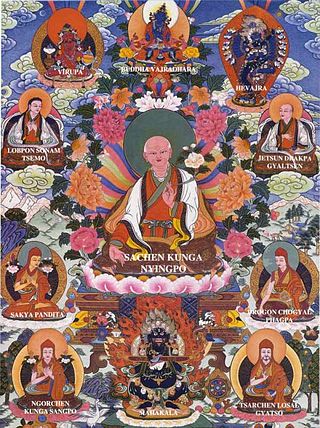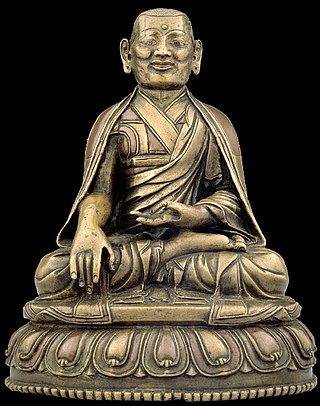Related Research Articles

The Sakya school is one of four major schools of Tibetan Buddhism, the others being the Nyingma, Kagyu, and Gelug. It is one of the Red Hat Orders along with the Nyingma and Kagyu.

The Kagyu school, also transliterated as Kagyü, or Kagyud, which translates to "Oral Lineage" or "Whispered Transmission" school, is one of the main schools of Tibetan Buddhism. The Kagyu lineages trace themselves back to the 11th century Indian Mahasiddhas Naropa, Maitripa and the yogini Niguma, via their student Marpa Lotsawa (1012–1097), who brought their teachings to Tibet. Marpa's student Milarepa was also an influential poet and teacher.
Drogön Chogyal Phagpa, was the fifth leader of the Sakya school of Tibetan Buddhism. He was also the first Imperial Preceptor of the Yuan dynasty and was concurrently named the director of the Bureau of Buddhist and Tibetan Affairs, serving during the reign of Kublai Khan.

Phagmo Drupa Dorje Gyalpo [1110–1170], was one of the three main disciples of Gampopa Sonam Rinchen who established the Dagpo Kagyu school of Tibetan Buddhism; and a disciple of Sachen Kunga Nyingpo [1092–1158] one of the founders of the Sakya school of Tibetan Buddhism. He was the elder brother of Kathog Dampa Deshek [1122–1192], who founded Kathog monastery and the Kathog branch of the Nyingma school.
Tai Situ Changchub Gyaltsen was the founder of the Phagmodrupa dynasty that replaced the Mongol-backed Sakya dynasty, ending Yuan rule in Tibet. He ruled most of Tibet as desi (regent) from 1354 to 1364. As a law-giver, politician and religious patron, he created a heritage that lasted centuries.

The Phagmodrupa dynasty or Pagmodru was a dynastic regime that held sway over Tibet or parts thereof from 1354 to the early 17th century. It was established by Tai Situ Changchub Gyaltsen of the Lang family at the end of the Yuan dynasty. The dynasty had a lasting importance on the history of Tibet; it created an autonomous kingdom after Yuan rule, revitalized the national culture, and brought about a new legislation that survived until the 1950s. Nevertheless, the Phagmodrupa had a turbulent history due to internal family feuding and the strong localism among noble lineages and fiefs. Its power receded after 1435 and was reduced to Ü in the 16th century due to the rise of the ministerial family of the Rinpungpa. It was defeated by the rival Tsangpa dynasty in 1613 and 1620, and was formally superseded by the Ganden Phodrang regime founded by the 5th Dalai Lama in 1642. In that year, Güshi Khan of the Khoshut formally transferred the old possessions of Sakya, Rinpung and Phagmodrupa to the "Great Fifth".

Rinpungpa was a Tibetan dynastic regime that dominated much of Western Tibet between 1435 and 1565. During one period around 1500 the Rinpungpa lords came close to assembling the Tibetan lands around the Yarlung Tsangpo River under one authority, but their powers receded after 1512.
Drakpa Changchub was a ruler of Central Tibet in 1374–1381. He belonged to the Phagmodrupa dynasty which was the dominating regime in Tibet between 1354 and 1435. Drakpa Changchub was the second son of Rinchen Dorje, a brother of the preceding regent Jamyang Shakya Gyaltsen. His mother was Zina Tashi Kyi. Like the other Phagmodrupa rulers he had a monastic upbringing, and was made abbot of Dansa Thel when fifteen years of age. In 1374 he was appointed regent (desi) of Tibet shortly after the demise of his uncle. For the next seven years he was jointly lama and regent. In 1381 he abdicated his political powers and retired to Dansa Thel in order to teach tantras. Since his reign was quite brief he was never formally acknowledged by the emperor of the Ming dynasty. He was succeeded as regent by his younger half-brother Sonam Drakpa.
Sonam Drakpa was a regent of Central Tibet who ruled in 1381–1385. He belonged to the Phagmodrupa dynasty, the leading regime in Tibet from 1354 to 1435.
Drakpa Jungne was a king of central Tibet who ruled in 1432–1445. He belonged to the Phagmodrupa dynasty which was the leading regime in Tibet from 1354 to 1435, and exerted some influence until the early 17th century. His reign saw the collapse of the political power of the dynasty, and the beginning of two centuries of internal strife.
Kunga Lekpa was a King of central Tibet who ruled from 1448 to 1481. He belonged to the Phagmodrupa dynasty, which was the leading political regime in central Tibet from 1354 to 1435, and retained a certain political status until the early 17th century. His time saw the further fragmentation of Tibetan politics.
Ngawang Tashi Drakpa was a king of Tibet who ruled in 1499–1554 and 1556/57–1564. He belonged to the Phagmodrupa dynasty which was the dominating regime in Tibet from 1354 to 1435 and maintained a degree of authority until the early 17th century. His rule is sometimes considered to be the last of importance in the history of the dynasty.
Ngawang Drakpa (Gyaltsen) (Tibetan: ངག་དབང་གྲགས་པ་རྒྱལ་མཚན, Wylie: Ngag dbang grags pa rgyal mts'an, d. 1603 or 1604) was a king in Central Tibet who ruled from 1554 to 1556/57, and again from 1576 to 1603/04. He belonged to the Phagmodrupa dynasty which held power in Tibet or parts of it from 1354 to the early 17th century. Due to the internal family feuds that preceded his reign most of the powers of his predecessor slipped from his hands.
Mipham Sonam Wangchuk Drakpa Namgyal Palzang was a king in Central Tibet. He belonged to the Phagmodrupa dynasty which reigned in Tibet, or parts of it, from 1354 to the early 17th century, and was the last prince of the dynasty.
Norzang (1403–1466), in full Norbu Zangpo, was the founder of the power of the Rinpungpa Dynasty in Central Tibet.

Sönam Gyaltsen, the Sakya Lama Dampa was a ruler of the Sakya school of Tibetan Buddhism, which had a precedence position in Tibet under the Yuan dynasty. He is considered the greatest Sakya scholar of the 14th century and served as ruler for a short term in 1344–1347.
Lotro Gyaltsen (1332–1365), in orthographic spelling bLo gros rgyal mts'an, was a ruler of Sakya, which had a position of precedence in Tibet under the Yuan dynasty. He reigned from 1347 to 1365; however, Sakya lost its influence in Central Tibet in 1354. In that way he was the last Sakya lord before the ascension of the new Phagmodrupa dynasty.
Kunga Gyaltsen was a Tibetan Imperial Preceptor (Dishi) at the court of the Mongol-led Yuan dynasty. He belonged to the abbot family Khon of Sakya which had a precedence position in Tibet in this era. He held the title from 1331 to 1358, being the last Dishi before the takeover of the Phagmodrupa dynasty in Central Tibet in the 1350s.
The Imperial Preceptor, or Dishi, was a high title and powerful post created by Kublai Khan, founder of the Yuan dynasty. It was established as part of Mongol patronage of Tibetan Buddhism and the Yuan administrative rule of Tibet.
References
- ↑ Stearns, Cyrus. Luminous Lives: The Story of the Early Masters of the Lam dre in Tibet. Wisdom Publications. ISBN 0-86171-307-9
- ↑ "The rise of Changchub Gyaltsen and the Phagmo Drupa Period″ in Bulletin of Tibetology, 1981 Gangtok: Namgyal Institute of Tibetology
- ↑ Dorje, Gyurme. Tibet Handbook: The Travel Guide. Footprint 1999. p.185 ISBN 1-900949-33-4
- ↑ Berzin, Alexandra A Survey of Tibetan History: 4 The Pagmodru, Rinpung, and Tsangpa Hegemonies
- ↑ Norbu, Dawa "China's Tibet Policy". RoutledgeCurzon 2001. p. 57
- ↑ Stoddard, E Heather (2002) Golden Buddhas from Tibet: Reconstruction of the Façade of a Stupa from Densathil.